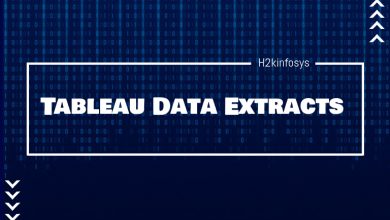Web Authoring in Tableau

Here, we will discuss about the Tableau Online environment that connects and prepare your data for analysis, creates a workbook, and share those insights with others.
Step 1: Sign in and explore projects.
Enter the user name and password to sign in to your Tableau site. Then, from the navigation pane, click on Explore to see all the content you can access across the site.
Initially, you will see Top-Level Projects. You can also browse these projects or select other content types.
Workbooks, data roles, data sources, and flows belong to projects, and projects can also contain nested projects. Similar to folders on your desktop, projects are a way to sort and manage content on your site. If you have been invited to an existing site, you may see projects created by your teammates.
Your site always comes with a default project, and you can use this project for your explorations if additional projects are not available.
Step 2: Creating a new workbook and connect it to data
In some way, you will need to connect to data to analyze it and build a workbook. As a Creator, Tableau allows you to connect to data sources directly on the web, or you can connect to the data sources published to Tableau Online through Tableau Desktop.
To begin, click on the New button and select Workbook.
The Connect to Data window will appear.
You can then connect to the data that will power your workbook in several ways:
- Connect to the published data sources from the On This Site tab.
- When you are provided with the Data Management Add-on with Tableau Catalog enabled, you can then use On This Site to connect to the databases and tables, as well as the data sources.
- Upload Excel/text-based data sources from the Files tab.
- Connect to the server or cloud data sources from the Connectors tab.
- On Tableau Online, you can quickly author and analyze data from LinkedIn Sales Navigator, Salesforce, Oracle Eloqua, ServiceNow ITSM, and Marketo from Dashboard Starters tab.
Tableau Catalog users can create workbooks using external assets:
When you consist of the Data Management Add-on with enabled Tableau Catalog, you can create a new workbook when you are making a Catalog-supported connection from the External Assets page:
And from database and table pages:
If Catalog does not support the connection, New Workbook doesn’t appear.
Step 3: Prepare your data.
After you are connected to data, use the data source page to prepare your data for analysis.
There are four areas under the data source page:
- Left pane: It displays details about your data. For file-based data, the left pane displays the file name and the worksheets in the file. For relational-based data, the left pane displays the server, the database or schema, and the tables in the database.
- Canvas: When you are connected to most relational and file-based data, you can easily drag one or more tables to the canvas area for setting up your Tableau data source.
- Data grid: You can use data grid for reviewing the fields and the first 1,000 rows of the Tableau data source’s data.
- Metadata grid: This button takes you to the metadata grid, which that displays the fields in the data source as rows so you can look at its structure.
You can also prepare your data for analysis on the data source page by:
- Renaming your data source
- Cleaning your data using the Data Interpreter
- Setting text file options.
- Relating your data
- Editing data columns
Once the data is ready for analysis, click on the Sheet 1 available at the bottom of the screen so that you are taken to the Tableau workspace for building a view.
Step 4: Authoring a view
You have connected to data, you have set it up for analysis, and now you are ready for creating a visual analysis of your data. If you have used Tableau Desktop before, the workspace area is very similar.
Workspace area:
- Workbook name. A workbook comprises of sheets. A sheet can either be a worksheet, a dashboard, or a story.
- Pages shelf, Filters shelf, Marks card – You can drag fields to the cards and shelves in the workspace for adding data to your view.
- Columns and Rows shelf – You can drag fields to the cards and shelves in the workspace to add data to your view.
- Toolbar – You can use the toolbar to access commands and analysis and navigation tools.
- View – It is the workspace where you can create your data visualizations.
- Side Bar – The side bar area comprises of the Data pane and the Analytics pane.
- Go to the data source page.
- Sheet tabs – These tabs represent each sheet in your workbook. This can include worksheets, dashboards, and stories.
Different ways to start building a view:
Every time you drag the field into the view/shelf, you ask a question about that data. The question varies depending on where you have dragged various fields, the types of fields, and the order in which you have dragged fields into the view.
For each question you ask, the view changes to visually represent the answer – with marks (shapes, hierarchies, text, table structures, color, axes).
In a worksheet, the columns from your data source are shown as fields on the data pane’s left side. The Data pane comprises of a variety of different kinds of fields, organized by the table.
When you start building a view, you can add fields from the Data pane. You can do this in different ways. For instance:
- Drag the fields from the Data pane and drop them on the cards and shelves that are a part of every Tableau worksheet.
- Double-click on one or more fields in the Data pane.
- Select one or more fields in the Data pane and then choose a chart type from Show Me, which identifies the appropriate chart types for the fields you selected.
Filtering data:
You may want to filter your data for only displaying a certain amount in your view. You can also filter your data in a number of ways, including:
For creating a filter in Tableau on the web, drag a dimension, measure, or date field to the filter shelf.
- When you have added a field to the filters shelf, an interactive filter will appear in the view. You can then select items you want to include/exclude from the view or select a range of values.
- You can also interact with the published view by selecting a single mark or click and drag in the view for selecting several marks. On the tooltip that appears, you can either select Keep Only to keep only the selected marks in the view or you can select Exclude to remove the selected marks from the view.
Using the Marks card:
You can also use the Marks card for adding context and details to the marks in your view. You can use the Marks card to set the mark type and encode your data with color, shape, size, detail, and text.
After you add the field to the Marks card, you can click on the icon available next to the field for changing the property it is using. You can then click the property buttons in the Marks card to change those settings.
Many properties can have multiple fields. For instance, you can add multiple fields to Label, Tooltip, Detail, and Color. Size and Shape only have one field at a time.
Undo your work:
Tableau is extremely flexible.
To undo or redo, click on undo or redo
on the toolbar.
You can also undo back to the last time you opened the workbook. You can also undo or redo an unlimited number of times.
Step 5: Present your work.
There are several ways for telling a story or persuade others with the data insights you have found in your views.
Format your work:
You can also format everything you see on a workbook, including parts of a view, your workbook’s fonts, and graph lines.
Dashboards:
A dashboard is a collection of numerous worksheets and supporting information shown in a single space so that you can compare and monitor different data simultaneously.
For opening a new dashboard sheet and start creating a dashboard, click on the New Dashboard icon at the bottom of the workbook:
The Dashboard area will appear on the left and lists the sheets in your workbook. You can also add one or more views to a dashboard, add objects such as blank space, web pages, and layout containers, or interactivity for associating different views on your sheet.
Step 6: Save your work
You can easily save your workbook at any time by selecting File > Save As. Your workbook will be saved into the folder it was created.
You can also save your data source for creating another workbook later or enable your team members to use that data for their analysis.
For saving a data source, hover over the data source name in the Data tab in the workspace until an arrow appears. Select the arrow and select Save.
When you are finished, choose File > Close to exit the workspace.
Step 7: Collaborate and share your findings
There are several ways to share your work and stay up-to-date.
Collaborate:
Other Creators in your organization can edit or update your workbooks and views if they have been given an access to your projects. Access is controlled by the site’s administrator, who can set project permissions, move content between projects, and also change a user’s role. If you have saved your data source, those users can connect to your data and use it for creating new workbooks.
Share Views and Insights:
Every view/workbook saved to your site can be shared via links in email and other applications or embedded directly into web pages, wikis, and web applications.
For seeing a view, users must have permission to access it in Tableau Server or Tableau Online.





